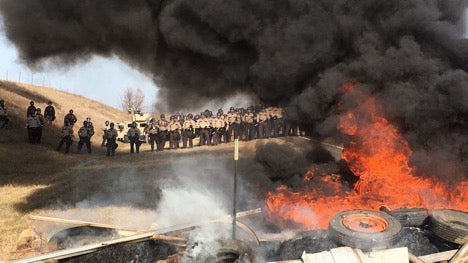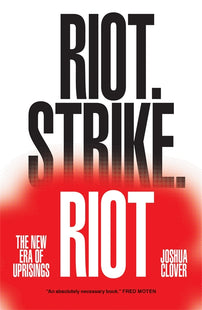Blockades and Border Walls
Are we in the early history of climate riots? What is already apparent is the state’s willingness to seize this situation on behalf of capital and of its own consolidation of power, a Green Nationalism which leverages climate management regimes toward hard borders, xenophobic violence, differential citizenship, protectionist labor pacts, further intensifications of militarization and surveillance.

An excerpt from the afterword of the updated paperback edition of Riot. Strike. Riot by Joshua Clover, now 50% off (until Tuesday, July 16 at 11:59PM EST) as part of our Beach Reads sale.
See all of our alternative beach reading here!
The lumpen appear first in a fairy tale. It begins, as fairy tales do, “Long, long ago.…” At their earliest chronological appearance in Capital Vol. 1, Marx writes with his coruscating sarcasm, In einer längst verfloßnen Zeit gab es auf der einen Seite eine fleißige, intelligente und vor allem sparsame Elite und auf der andren faulenzende, ihr alles und mehr verjubelnde Lumpen. “Long, long ago there were two sorts of people,” runs the standard translation, “one, the diligent, intelligent, and above all frugal élite; the other, lazy rascals, spending their substance, and more, in riotous living.” We do not hear this origin story until quite late in the book, at exactly the moment that Marx has leapt from his logical argument back into the depths of history so as to explore “The Secret of Primitive Accumulation.” The narrative strategy is much remarked. This could have been the first chapter; it is where the fabula begins, after all. But then it would be some seven hundred pages away from “The General Law of Capitalist Accumulation,” where the all too real fate of the lumpen is disclosed. Having been driven into labor and transformed into the proletariat, setting forth a logical sequence that organizes the book’s first twenty-five chapters, some increasing fraction are expelled from production according to the rising technical and organic compositions of capital, and thereby sediment into informal labor, absolute pauperism, and superfluity at depths below even the relative surplus population’s misery. In this way the beginning and the end of the lumpen’s traverse are found adjacent, as if to insist that we reflect on this trajectory directly. We might simply say that this book concerns the politics of that arc.
By politics here I mean the various ways in which proletarians have fought to transform their circumstances, the changing ways in which they have drawn from the repertoire of collective action. That they have indeed changed is not a matter of dispute, and the research program of historical materialism means to understand the bases for these changed. The book’s contribution to this research remains distinct from the accounts launched from legacy socialist journals with their imperative modes, insisting on what proletarians should do. To the extent that this book is future-facing in the way that it adduces forms of collective action to political-economic developments along a historical trajectory, it might be understood as predictive rather than prescriptive.
It is instructive to consider concrete struggles of late for the ways that they affirm or challenge the book’s framework. One might suggest that the sudden intensification of social conflict around airports and air travel does both. Exemplary among these are the US airport shutdowns of 2017 in defiance of the Trump administration’s “Muslim ban”; blockages of access roads, runways, and service personnel to prevent immigrant deportations, notably but not exclusively in the UK; and work withdrawals actual and threatened, notably by air traffic controllers and flight attendants, in the face of the longest budgetary shutdown in US history. This last example underscores the enduring power of labor struggles, though we should be attentive to the ways that this incident was wage-related only in the sense that the Federal employees involved were temporarily not receiving pay; there was no negotiation of wages, work conditions, or better footing for future bargaining (notably, the action summoned the repeated description of a nascent “general strike”).
At the same time, this gathering of actions underscores the airport as a site of transport struggle (here we recall the parallel work stoppage by taxi drivers during the 2017 airport occupations). Even more significantly, these mark the airport as both fact and figure of global circulation; if there is a further theme uniting these actions it concerns immigration and refugees. We might see these actions aggregately as a discontinuous front opened against the remaking of border regimes that design to limit the free flow of people while preserving the free flow of capital, scarcely a new project but one that has come to dominate state strategy in the overdeveloped world. The wall along the Mexican border that possesses Donald Trump’s imagination is the paradigmatic representation of a global project, elsewhere prosecuted through legal regimes, surveillance practices, political relation to the European Union and Schengen Area, and further measures—the state’s very own circulation struggle.
One might set in suggestive relation to this the most sustained and ambitious social contest since the book’s original publication, certainly in the US: the Standing Rock encampment against the Dakota Access Pipeline (the so-called NoDAPL movement), a circulation struggle of extraordinary scale and intensity that located its politics in relation to land sovereignty and to environmental despoliation while understanding its tactical power to lie in the interruption of infrastructural development, of fossil energy flows, and of profits. NoDAPL demands a more sustained treatment than is allowed by this afterword; it will nonetheless be useful to briefly trace its history.
It may be the case that the most successful deployment of circulatory strategies in recent decades is that of the piqueteros in Argentina, who succeeded in breaking multiple governments during a period of sustained political-economic volatility while metastasizing into a broad movement of the unemployed (Movimientos de Trabajadores Desempleados), always the most dialectically insistent subjects of the shift into circulation. That said, one fundamental prehistory of the present circulation struggle lies in Indigenous resistance to the colonial projection of power, wherein economic imperatives for resource extraction and distribution become the justification for state imposition of sovereignty claims which will be necessary for further profit-taking and so on in a cycle that elucidates the particular synthesis that Glen Sean Coulthard calls “settler capital.” Within this history of extractivist settler-colonial economies it is somewhat more difficult to speak of a shift to circulation, as they have by and large not followed the same developmental path to deindustrialization worn by the early-industrializing nations. There is a prolonged tradition of infrastructural blockades, occupations, and encampments in First Nations territories that would provide the framework for NoDAPL.
The most immediate precursor, the Idle No More movement that peaked in 2012–13, originated as a hunger strike in protest of omnibus Bill C-45, whose salient features delivered economic development and settlement of reserve lands while degrading environmental protections. Shortly, as Coulthard describes it, “Idle No More tactics began to diversify to include the use of blockades and temporary train and traffic stoppages, the most publicized of which involved a two-week railway blockade.” This falls within a longer tradition that seeks “to impede or block the flow of resources currently being transported to international markets from oil and gas fields, refineries, lumber mills, mining operations, and hydroelectric facilities located on the dispossessed lands of Indigenous nations [so as] to have a negative impact on the economic infrastructure that is core to the colonial accumulation of capital in settler-political economies like Canada’s.” Coulthard understands these land-based forms of direct action to be longstanding as they lead toward the formation of what Naomi Klein will describe, in her book on ecological crisis, as “blockadia.” At the same time, writing in 2014, Coulthard specifies that such actions, with blockades taking pride of place, have been the pivotal feature of “all negotiations over the scope and content of Aboriginal peoples’ rights in the last forty years,” reaching back to the 1970s. The correspondence with the trajectory of deindustrialization and with the long crisis of US-centered accumulation is remarkable.
Pipeline and airport blockades together insist on the two themes of immigration and ecology, which is say, antagonisms around borders and climate catastrophe. These provide in coordination with the classical and modern aspects of the riot (that is, from the preindustrial era and the age of racialized surplus populations) something approaching a full orientation toward the future of circulation struggles.
As we have already seen in varying ways, perhaps most dramatically with the Gilets Jaunes movement, proletarians are cast on either side of both matters, immigration and ecology. But again we must recognize that these two matters are one. While border regimes will continue to provide a way for the capitalist class to manage labor markets, the international labor flow is already in the process of converging with the increase of climate refugees, a current which the inundation of coastal cities over the near future will only accelerate. When this phenomenon is viewed from the counterposition, the seeming need to husband diminishing “natural resources” provides a readymade rationale for intensified policing of borders. It matters little whether one conceives of climate collapse as cause of refugees, or refugees the source of resource burdens. In the present world, immigration has become an ecological fact, ecology a matter of immigration.
This is simple and absolute: immigration battles and climate collapse share a single basis in what we might call “exhaustion capitalism,” a capitalism worn thin, its engine casting off labor as the exhaust of hyperproductivity, voraciously exhausting resources necessary for its survival.
One can begin to imagine the political forms this will take. What if the US state, adopting the reasoning and rhetoric of the very antagonists it so diligently endeavored to crush at Standing Rock, declared that a planned border wall with Mexico was not meant to deter the threat of terrorists, gangs, traffickers, and other imagined malefactors, but rather was a project along the lines of NoDAPL’s “water protectors,” preserving resources against destructive consumption and indifferent despoliation? Here the historically xenophobic framework of the Malthusian “population bomb” is buttressed by the pseudo-ethical demand of ecological preservation, underwritten by a practical competition for survival resources. From the perspective of nations wealthy enough to afford even a minimal bulwark against climate collapse for some privileged fraction of its citizenry, the floods of rising seawater and of refugees will run together, both figured as inundations.
This dystopia is already here. The exigencies of declining living standards and life chances, the Gilets Jaunes’ end-of-the-month desperation entangled already with Macron’s ecological claim, disclose this sequence as the early history of climate riots: uprisings which, whatever their declared theme, are conditioned by threat of climate collapse and grim panic over population control. What is already apparent, and will no doubt become more so is the state’s willingness to seize this situation on behalf of capital and of its own consolidation of power, a Green Nationalism which leverages climate management regimes toward hard borders, xenophobic violence, differential citizenship, protectionist labor pacts, further intensifications of militarization and surveillance. Arguably most disturbing for those historically identified with the left is the inclination of left parties across Europe and beyond to follow this shift, whether cynically chasing votes or indulging the belief that a strong homeland is a bulwark against global finance. This political collapse discloses other axes that superpose themselves to that of right/left; in both the labor market and the sovereign nation, the axis of inclusion/exclusion will structure social conditions in the first instance. Against this, against the varied impositions of immiseration, climate riots and their cousins are likely to ascend in significance, riven by contradiction and driven by immediate requirements for survival. Thoroughfare, public square, pipeline, railway, dockside, airport, border, these will be our places.
